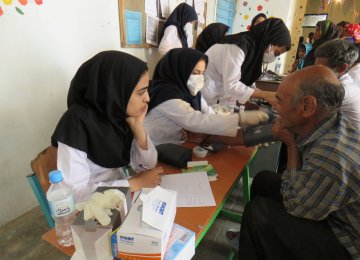The number of physicians in remote regions increased by almost three times under the 2014 Health Reform Plan, according to the deputy for technical and planning affairs at the Health Ministry.
“There were only 1,400 doctors in remote and underprivileged regions prior to 2014, which has increased to 4,340 now,” Ali Maher was quoted as saying by IRNA.
Health reforms, a legacy of the Rouhani administration, were launched in line with the national 2025 vision plan as well as Iran’s Health Innovation and Science Development Plan, both of which envisage sustainable development in medicine, health and related technology.
In January 2015, Health Minister Hassan Qazizadeh Hashemi announced that a network of 12,500 doctors would be created to link big cities and small towns to strengthen solidarity among the medical fraternity.
The plan, a first of its kind, was initially launched in Fars and Mazandaran Provinces with each province establishing a Comprehensive Health Center that covered as many as five smaller health centers.
So far, the plan covers nearly 10,000 physicians and 9,500 healthcare facilities, 1,300 of which were connected in the past fiscal year that ended in March.
“This is also aimed at boosting health facilities in remote areas,” Hashemi had said.
In November 2016, around 2,000 specialists in 27 medical fields were dispensed across 580 state-run hospitals in 378 cities. Most of the specialists who are in the remote areas are active in the fields of internal medicine, pediatrics, obstetrics and gynecology.
The ministry has also tried to improve conditions and offer better financial support for physicians in far-flung areas to encourage doctors to practice in these places. The monthly salaries of permanent village doctors more than doubled in recent years and is now twice the salary of practitioners employed in cities.
Medical students who graduate from state universities are currently required to mandatorily serve in rural regions for two to four years.
According to the Iran Medical Council, there are 78,000 general practitioners (GPs), 36,000 specialists, 24,000 general dentists, 2,000 dental specialists, 36,000 midwives, and 15,000 physiotherapists, nutritionists, optometrists, and audiologists in the country. Almost 40% of all physicians work in Tehran Province.
E-Healthcare
In order to improve healthcare in remote and rural areas, the government launched a nationwide e-healthcare project in August 2015 to employ electronic healthcare (e-health) infrastructures including telecommunication and information technology to provide clinical healthcare to all rural regions.
E-health allows remote patient monitoring through mobile technology and reduces the need for outpatient visits; it enables remote prescription verification and drug administration, and has the potential to significantly reduce the overall cost of medical care.
As a precondition for e-health, electronic health files have been created for 60%-70% of the people in every province on average. In certain provinces, particularly the lesser developed ones such as Chaharmahal-Bakhtiari and Khuzestan, the coverage has surpassed 85%, according to health Ministry Spokesperson Iraj Harirchi.






Add new comment
Read our comment policy before posting your viewpoints